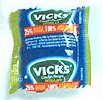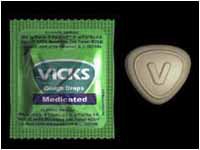
Company : P&G
Agency: Ambience
Vicks is a brand that is more than 50 years old. Vicks is a leading brand in the Fast Moving Health goods ( FMHG). FMHG industry in India is worth around 4500 crores. This market is dominated by products like Rubs & Balms, medicated skin treatments,cough syrup and drops, digestives and health supplements.
Vicks Brand was launched in India in 1951 . It was manufactured by Vicks Products Ltd. Later in 1964, Richardson Hindustan Ltd was formed to manufacture the product .In 1985 RHL became the affiliate of P&G. In 1989 RHL became P&G hygiene and health care.
Vicks in India is known for its VapoRub and cough drops. Globally Vicks brand is worth around 3000 crores.
Vicks vaporub is the market leader in this segment with a share of 50%. Vaporub was initially targeted at children but later the company found out that it is used mostly by adults. Vicks Vaporub is positioned along Mother's Love platform . Vaporub pioneered the concept of " Touch therapy" linking it to the rubbing of vaporub on the child's chest. Vaporub advertises itself as having 6 key benefits
1. Clearing blocked nose
2, Cough relief
3. Body ache relief
4. Head ache relief.
5. Relaxing muscle stiffness
6. Easing breathing difficulty.
Vaporub also ranks best among the consumers in the following parameters : Non greasy, Smells better, Long lasting relief. Greasyness was important because Iodex ( a different category product) failed because of greasyness.
The rencent ad campaign also involves " father " in to the picture. The ad shows a father taking care of the child using Vaporub when the mother is away. The smart positioning and campaigns has ensured the brand retaining the top position in the market.
Vicks Co
 ugh drop is another blockbuster from the Vicks stable. Vicks commands a generic recall in this category. Using brand imagery and the catchy charachter " Kitch Kitch", Vicks commands a major share in this market. With unique shape and the long lasting positioning "Vicks ki goli lo Kitch Kitch door karo" , Vicks is a super brand in this category .Vicks coughdrops were careful in not messing up "Kitch Kitch" .This has ensured that the brand enjoys excellent recall .The recent campaigns of Vicks-Honey also strengthens the time tested positioning of the brand.
ugh drop is another blockbuster from the Vicks stable. Vicks commands a generic recall in this category. Using brand imagery and the catchy charachter " Kitch Kitch", Vicks commands a major share in this market. With unique shape and the long lasting positioning "Vicks ki goli lo Kitch Kitch door karo" , Vicks is a super brand in this category .Vicks coughdrops were careful in not messing up "Kitch Kitch" .This has ensured that the brand enjoys excellent recall .The recent campaigns of Vicks-Honey also strengthens the time tested positioning of the brand.Vicks Action 500 has been in the market for more than 25 years. Launched in 1979 this is the first advertised OTC brand in India. Over these years the brand has carved a position for itself with around 40% market share in the category. This brand which is no
 w relaunched talks about its ability to provide relief from cold related symptoms. This product is in Caplet shape ( capsule shaped tablet) which makes it different from its competitors and reinforces its ability to cure two symptoms of cold : blocked nose and headache .
w relaunched talks about its ability to provide relief from cold related symptoms. This product is in Caplet shape ( capsule shaped tablet) which makes it different from its competitors and reinforces its ability to cure two symptoms of cold : blocked nose and headache .
Vicks Inhaler was launched in 1951 created and own the inhaler category is one of the first products launched in India from Vicks.
Vicks recently ventured in to the 550 crore cough syrup market with its Formula 44 in October 2003. The brand's usp is 8 hours relief from cough. The product is targeted at kids .The insight is that the power of most of the Cough syrups wanes after 5 hours and long lasting relief is the platform that Vicks is banking on for this product.
 thee customers. The FMHG market calls for Umbrella branding since it is difficult and expensive to create trust for individual brands in that category .That is the reason behind Vicks extending its equity across the various categories. Vicks has used careful branding and packaging for promoting the products. The unique shapes of cough drops, inhaler and caplet are examples of using product form as a differentiating factor.
thee customers. The FMHG market calls for Umbrella branding since it is difficult and expensive to create trust for individual brands in that category .That is the reason behind Vicks extending its equity across the various categories. Vicks has used careful branding and packaging for promoting the products. The unique shapes of cough drops, inhaler and caplet are examples of using product form as a differentiating factor.












